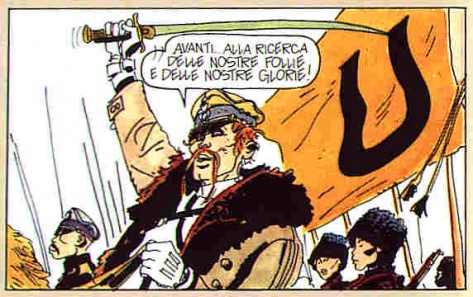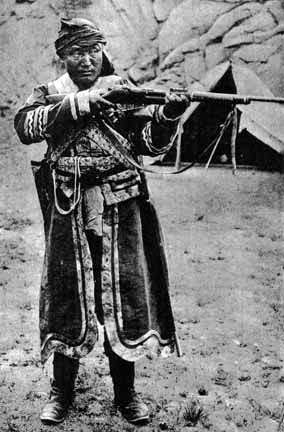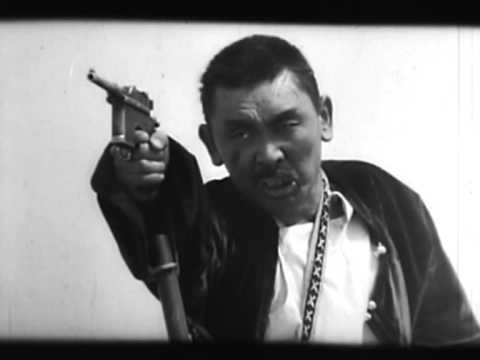- A
- A
- A
- ABC
- ABC
- ABC
- А
- А
- А
- А
- А
Introduction to Daurian Gothic
© WIKIMEDIA COMMONS
Medieval horror, vampires, sorcerers, mysterious monks and the rising dead, alongside real historical figures and stories about the Russian Civil War wrapped in the aura of mysticism – this is perhaps the shortest formula for Daurian Gothic. Alexei Mikhalev, Doctor of Political Science, discusses this phenomenon and its evolution.
Western East
Daurian Gothic is a neo-romantic trend in art characterised by a murky atmosphere and mythologised stories of wars and conflicts in Transbaikalia (Dauria) and broader Inner Asia.
Inner Asia refers to a culturally insulated steppe region which includes Tuva, Buryatia, Mountain Altai, and also Mongolia and Tibet. The region's mythology consists of legends about Llamas, Buddhism, yogis, the search for Shambhala, and others. Daurian Gothic, however, reinterprets these legends from a European perspective and adorns them with Western motifs. As a genre, it is reminiscent of Asian Gothic – Japanese, Korean, Chinese, Thai, Singaporean, etc.
Daurian Gothic is reflected in literature, comics (manga), anime and rock music. Its imagery and demonic monochrome atmosphere are typically Gothic, with horror and mysticism, walking dead, ghosts, soothsayers and werewolves, wolves and crows, and other tropes, existing in an isolated topos (imaginary Inner Asia) outside of people's everyday life. Specifically, this mysterious and macabre style is used to depict a key protagonist of Transbaikalian Gothic, Baron Roman von Ungern-Sternberg (1886-1921) who was in fact a real historical person, commander of the Asian Cavalry Division (made up mainly of Buryats and Mongols) and one of the most infamous figures of his time.

Other classical motifs can also be found in Daurian Gothic, such as divine madness (ecstasy, trance, etc.), mysterious castles, and others – all set in an Oriental context: Buddhist monasteries, castles amidst the vastness of the steppe, shamans as sorcerers, mysterious Tibetan monks and lamas, and the Doors of Shambhala instead of the Holy Grail and other symbols of grace. The Daurian feudal lord, Ungern himself, is cross between Western and Eastern imagery: a knight crusader and a Buddhist, a local king and a White Khan. Revered as the God of War (the Tibetan Jamsaran) by the Mongols, Ungern acquires certain attributes of Odin in Daurian Gothic, e.g. he is often accompanied by a raven and a wolf. Ironically, this eclectic imagery suits the real Baron's contradictory nature – more on that below.
Transbaikalian Pantheon
The poetics of Daurian Gothic are reflected in the chapter titles of Beasts, Men and Gods (1922), a book about Ungern by Ferdynand Antoni Ossendowski, a Russian-Polish explorer and right-wing political activist, who was largely behind the Baron Ungern myth.
Eyewitness to the Russian Civil War in Siberia and Mongolia, Ossendowski wrote a fictionalised history of the events. Having met Ungern in person, Ossendowski reimagined and romanticised this historical character, as can be seen from book chapter titles such as The March of Ghosts; The River of the Devil; Mysteries, Miracles and a New Fight; The Breath of Death; The Subterranean Kingdom; An Old Fortune Teller; The Mysterious Lama Avenger; A Bloody Chastisement, and others. While many motifs and images were stale clichés, they worked well as myth material.
Similarly mystical and romantic are the descriptions of other characters, such as Ja Lama, Urzhin Garmaev, and others.
Garmaev, a Buryat officer in Ataman Semyonov's army and subsequently General of the Imperial Japanese Army, was a controversial figure who commanded the preparations for armed attacks against the Soviet Union. Ja Lama was a warlord and leader of the liberation movement in Western Mongolia in the 1910s, but at the same time he was a sorcerer, adventurer and robber who called himself a lama.

Origins of Myth
Two works of fiction, both about Ungern, lay the foundation of the genre: one was the aforementioned Beasts, Men and Gods by Ossendowski and the other was The Ballad of Daur Baron (1928) by Arseny Nesmelov, an émigré poet and representative of Russian literature in Harbin. In the Ballad, Gothic motifs are emphasised to an extreme degree. Like a horseman of the Apocalypse, the Mad Baron appears 'out of nowhere' riding a black horse, descends and 'walks towards the hacked corpses', and pierces some of them with a dagger, his eyes shining demonically in the darkness, to the accompaniment of a raven’s caw and the howling of steppe wolves.
Both texts were written by their Russian authors in emigration: one in Poland and the other in China (Harbin). Meanwhile, the myth was expanding. According to Mikhalev, 'All sorts of memoirs, alongside outright mystifications, were written by former officers of the Asian Cavalry Division as well as by literary authors'.
White émigrés from Russia set a romantic tone to the story of this extremely controversial man whose figure was thus made canonical and immune to criticism. Apparently, the émigré circles never intended to engage in honest reflection into the Ungern case but focused on promoting right-wing political ideas, and Nesmelov and Ossendowski's writing fit this purpose well.
There was another source of the Ungern myth: Alfred Rosenberg, a key Nazi ideologue, described the Baron as 'the ideal Aryan', Mikhalev notes. The Third Reich's propaganda machine depicted Ungern as 'the first leader of a new type, the first Nazi.' Legend has it that Rosenberg dedicated a theatrical play to Ungern, and it ran in German theatres in the 1930s.
Aura of Middle Ages
Here is Ossendowski's dramatic description of everyday life in the Asian Cavalry Division: 'Thus lived this camp of martyrs, refugees pursued by events to their tryst with Death, driven on by the hate and contempt of this offspring of Teutons and privateers [Ungern]. And he, martyring them, knew neither day nor night of peace. Fired by impelling, poisonous thoughts, he tormented himself with the pains of a Titan, knowing that every day in this shortening chain of one hundred thirty links brought him nearer to the precipice called Death'.
According to Mikhalev, this grandiloquent passage reflects both 'the fictitious prediction that "one hundred and thirty steps are required by the God of War" and the legend of the Great Unknown – the latter borrowed from Helen Blavatsky's Secret Doctrine'.
Another eyewitness to the 1921 events of in Mongolia, ethnographer Dmitry Pershin, shared his own observations which partly explain how and why the Ungern myth came about. 'The Baron had a medieval aura about him, something that felt atavistic, as if inherited from his distant ancestors, knights and crusaders: the same thirst for military life and, perhaps, the same belief in the supernatural and other-worldly', Pershin wrote. 'He [Ungern] was superstitious and always accompanied, even during military campaigns, by lamas, fortune-tellers and soothsayers. Many people took advantage of this weakness, including a certain Ossendowski who wrote a book fool of nonsense [about Ungern]'.
But what was the Baron's real story? There have been attempts to reconstruct it, including as a work of fiction. In 1993, Leonid Yuzefovich published an investigative novel entitled The Sovereign of the Desert. The Phenomenon of Baron Ungern's Fate (according to Mikhalev, this book is also part of the Daurian Gothic canon). The life of the 'white Khan' has also been studied both in and outside Russia, but many researchers found it hard to avoid fictionalising their findings.
Very briefly, Ungern's story was as follows. The Red Army's offensive and guerrilla actions in Transbaikalia led to the defeat of the White Army. Retreating from Dauria, the Baron invaded Mongolia (1920) and expelled Chinese troops from its capital city of Urga, and then restored the Buddhist theocratic monarchy in Mongolia. At the end of the story, his own officers conspired against Ungern and gave him up to the Bolsheviks who tried, convicted and executed him. Claims that the Baron was enchanted against bullets proved to be untrue. However, his marriage to the Chinese princess Ji appears to be fact, but this romantic story must have had the pragmatic purpose of fitting in with the local community.
Whims of Sacralisation
The legend continued after Ungern's death: various political movements, from nationalists to monarchists, invented their own 'Ungern'. He has even been described as a philosopher and Eurasian ideologist. Grand Duke Vladimir Kirillovich once controversially compared Ungern to prominent philosophers such as Peter Savitsky and Lev Karsavin.
According to Mikhalev, the Baron's undeserved sacralisation began while he was still alive. The then head of the Mongolian Buddhist Church and supreme ruler of Mongolia, the 8th Bogd Gegen, pronounced Ungern to be a reincarnation of a Buddhist deity. In fact, the Baron's memory goes beyond what Mikhalev calls 'traditional politicisation of memories from the Russian Civil War'.
The political scientist writes: 'The extent of Ungern's mythologisation is comparable only with that of Vassily Chapaev (which is reflected in Viktor Pelevin's novel). According to our hypothesis, the reason is that Ungern's cult – in contrast to those of Kolchak or Krasnov – originated in the 1930s in Nazi Germany. Today's imperialists and the far right reproduce old ideological patterns and myths in new contexts; how these historical myths are created and what historical figures come to the fore is particularly significant. Baron Roman von Ungern-Sternberg, of all White Movement leaders, has been revered not only in contemporary Russia and in 1930-1940s Germany but also in Mongolia. Ungern's memory has been used to consolidate diverse political forces'.
Sometimes, the manner in which this character is worshipped amounts to fetishism. There are T-shirts with his face on them and even non-canonical Buddhist tanks (icons) depicting Ungern as a dokshit (defender of the Faith).
Daurian Transylvania
According to principles of the Gothic genre, its chronotope, i.e. literary and artistic representation of space and time, is also mythologised. Mikhalev notes that Gothic literature is often about 'rebellion against the modern world'. In Daurian Gothic, the Middle Ages have a positive connotation for being closer to nature and Truth, as opposed to modern times which are viewed as rather negative. Explorer of the region, historian and traveller Andrei Strelkov uses the metaphor 'Tibet's frozen time' to indicate a certain reference time that evokes nostalgia.
Dauria has been fictionalised in the same way that Transylvania is believed to be the domain of Dracula (Vlad Tepes), and the Daurian heroes appear as demonic as the Wallachia ruler. There are historical reasons behind this perception: according to eyewitness accounts, Baron von Ungern-Sternberg scarcely valued human life and spared neither his own soldiers, nor women, children or the elderly. As a result of his orders, entire communities were massacred (his ruthlessness, however, was consistent with the bloodthirsty attitudes of his chief, Ataman Grigory Semyonov). According to Italian philosopher Julius Evola – also a controversial figure – Ungern's 'great passion had burned out every human element in him'. Here is how one of the Baron's colleagues described him: 'He was brutal and pitiless as only an ascetic could be... His insensitivity exceeded all that one can imagine, and would seem to be discoverable only in an incorporeal being, with a heart as cold as ice, knowing neither pain nor pity, neither joy nor sadness'.
Adventurers and Impostors
Black Baron, God of War, Warrior of Shambhala, Mad Baron, Mahakala (protector of the Buddha’s teachings), descendant of the Huns – these are some of the numerous names Ungern was called. Also numerous were impostors who declared themselves his true descendants. Since his death, people have been searching for Baron Ungern's treasure in different parts of Mongolia and Transbaikalia – with the same zeal as some others have searched for the treasure allegedly buried by Yemelyan Pugachev.
But the truth is that Ungern – similarly to Pugachev in his time – was hated not only by his enemies (the Reds) but also by his many associates (the Whites) who believed that the Baron's unparalleled cruelty and recklessness had discredited the White Movement's ideals. Indeed, Ungern's units were virtually indistinguishable from the Hunghusians, Manchu (Chinese) robbers raiding the region at the time. Just like the Manchu gangs, the Asian Division ravaged the area, robbing settlements and monasteries.
Pyotr Wrangel, who at some point was Ungern's commander, described it as 'Robin Hoodism gone wrong' and insisted that Ungern was not a military officer in the proper sense but an amateur guerrilla fighter or a 'hunter from a Mayne Reid novel'.
Wrangel referred to Ungern as a man who 'lived by war'. Ungern's other characteristics from the same description ranged from 'a sharp mind' to 'an astonishing lack of culture', to 'extreme narrow-mindedness', 'shyness' and 'insane impulsivity'.
As noted above, there were other impressive characters inhabiting the Mongolian 'Transylvania' at the time, such as Ja Lama, commemorated in film (Icheend N', 1972, directed by Badrahin Sumhu) and history papers (by researcher of Mongolia Inessa Lomakina). Some rock songs, e.g. by the Kalinov Most folk rock group, also feature a semi-legendary chronotope and romanticised 'strange heroes'.

Political Samizdat
Since the 1990s, a variety of books have been published featuring the events in Transbaikalia and Mongolia, including 'naive' literature and writings by fan communities, as well as books by professional authors printed by major publishers, and also manga (featuring Ungern or Urzhin Garmaev, very often in self-produced, aka samizdat form) and anime. This genre fits well with the Korean Wave (Hallyu), i.e. the global expansion of South Korea's pop culture from music to TV drama, which, according to Mikhalev, 'has overtaken Russia's Asian territories up to Baikal'.
It is no surprise that different political groups each have their own version of Ungern: his biography lends itself to commemoration and has provided fertile ground for many legends, which, in turn, can be further revisited and reinterpreted.
IQ